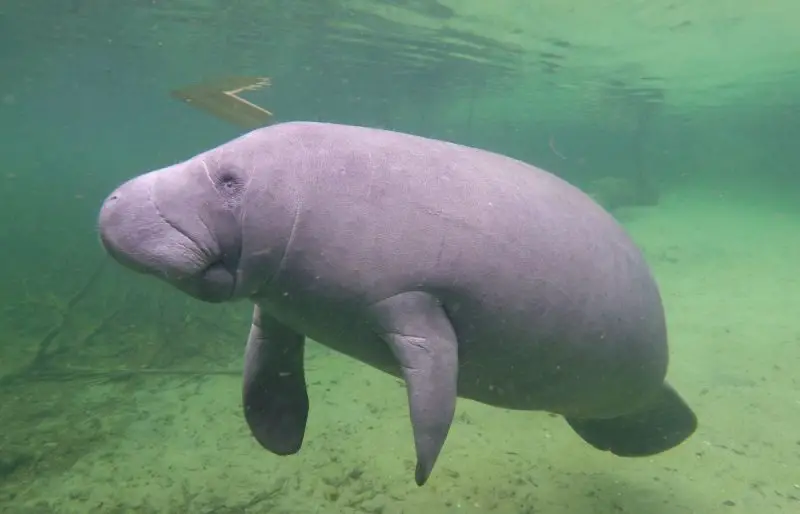Manatees are some of the most recognizable and cherished aquatic animals found in Florida’s rivers and coastal habitats. Known for their gentle demeanor and slow-moving grace, these herbivorous mammals attract tourists and scientists alike. But while most people associate manatees with dolphins or seals due to their aquatic nature, their closest living relatives might surprise you. Believe it or not, manatees are more closely related to elephants than any marine animal. This unusual connection opens up an incredible world of evolutionary biology, paleontology, and shared traits between two species that, at first glance, couldn’t seem more different.
Understanding how these two seemingly unrelated creatures are connected requires a dive into their evolutionary history, biological characteristics, and shared ancestry. This unique bond also helps explain certain peculiarities in manatee behavior and physiology. As we explore this connection, we’ll uncover why Florida is the perfect setting to study these aquatic giants and how elephants and manatees share a past that dates back tens of millions of years.
Florida’s manatees have become not only a biological curiosity but also a conservation icon. While learning about their link to elephants may feel like a fun fact, this knowledge also plays a role in how scientists and conservationists approach their protection. By examining this connection in depth, we gain a more profound understanding of life’s evolutionary web and our responsibility to safeguard its diversity.
Evolutionary Roots: A Shared Ancestor

Both manatees and elephants belong to a group of mammals known as Paenungulata, which also includes hyraxes. This clade is part of a larger order called Afrotheria, which originated in Africa over 60 million years ago. While it might seem odd that aquatic manatees and massive land-based elephants could share a lineage, the fossil record supports this connection through various transitional species and anatomical features that point to a common ancestor.
This ancient ancestor likely lived on land and had traits that would later evolve into characteristics seen in both manatees and elephants. Over millions of years, some lineages adapted to life on land and became large, terrestrial herbivores—eventually becoming elephants. Others found new ecological niches in water-rich environments and gradually developed adaptations for an aquatic life, evolving into the modern-day manatee.
Although the evolutionary paths of manatees and elephants diverged long ago, both species still retain key genetic and anatomical features that reveal their ancient connection. These include similarities in their teeth, internal organs, and even reproductive systems. Their shared evolutionary history isn’t just a trivial note; it provides insight into how animals adapt to dramatically different environments while maintaining a surprising number of similarities.
Anatomy Tells the Story
When comparing the anatomy of manatees and elephants, certain features stand out as strong indicators of shared ancestry. For example, both animals have similar tooth replacement patterns. Elephants and manatees grow new teeth at the back of the mouth, which slowly push forward to replace worn-out ones at the front—a trait virtually unheard of in other mammals.
Additionally, manatees and elephants both have thick, wrinkled skin and sparse body hair, a trait that sets them apart from most mammals. Their nail structure also points to a common lineage, particularly in the bones of their flippers (manatees) and limbs (elephants). Both species possess five digits beneath the skin—though these digits serve different purposes in their respective environments.
Even in the realm of internal organs, manatees and elephants share striking similarities. Both have similar lung structures, which are long and extend horizontally, allowing for efficient respiration in large-bodied animals. This configuration aids buoyancy in manatees and helps support the massive frame of elephants on land.
The reproductive systems of these two mammals also offer evidence of a close relationship. Both have long gestation periods—manatees for about 12 months, elephants for up to 22 months—and their calves are born relatively well-developed. This similarity reflects a slow reproductive strategy common among large herbivores that invest heavily in raising fewer offspring with greater survival chances.
Fossil Records and Ancient Relatives
The fossil record gives us more than just bones—it tells a story of migration, adaptation, and survival. Scientists have unearthed fossils of ancient manatee-like creatures that had limbs capable of both walking and swimming. These extinct animals, such as Pezosiren portelli, are considered transitional species that link land-dwelling mammals to modern-day sirenians (the group that includes manatees and dugongs).
Pezosiren, discovered in Jamaica, lived about 50 million years ago and had features that were both elephant-like and manatee-like. It walked on four legs but had a body and skull shape more akin to a manatee. Fossils of early elephants, such as Moeritherium, show similar timelines and characteristics—pointing to a shared evolutionary divergence around the same era.
These discoveries are more than historical curiosities. They provide context for understanding how manatees came to inhabit the warm waters of Florida and why their bodies evolved to thrive in this unique habitat. The common traits they share with elephants aren’t just remnants of ancient genetics—they’re adaptations that helped each species survive in dramatically different environments.
Florida’s Role in the Manatee Story
Florida is a natural haven for manatees, offering warm waters, abundant vegetation, and year-round freshwater sources. The state’s spring-fed rivers and coastal estuaries provide ideal conditions for manatees to feed, rest, and migrate during seasonal changes. Notable places like Crystal River, Blue Spring, and Homosassa Springs have become iconic spots for observing manatees up close.
But why Florida? The answer lies in the warm water outflows from natural springs and power plants. During colder months, manatees seek refuge in these warm areas, where temperatures remain stable and food sources are abundant. The protection of these areas has become critical to the manatee’s survival, particularly as the species faces threats from habitat loss, boat strikes, and pollution.
The presence of manatees in Florida also presents an extraordinary opportunity for education and research. Wildlife centers and conservation programs across the state use this visibility to teach the public about manatees’ evolutionary history and their connection to elephants. By understanding this unique relationship, visitors can appreciate the importance of preserving both the creatures and the ecosystems they depend on.
Conservation Lessons from Elephants and Manatees
Conservation efforts for both elephants and manatees have much in common. Both species are slow to reproduce, which makes them highly vulnerable to environmental changes and human interference. The threats they face—whether it’s habitat destruction in Africa and Asia for elephants or boat traffic and pollution in Florida for manatees—are strikingly similar in nature.
Organizations working to protect these animals often draw on shared strategies, including habitat preservation, public education, and strict legal protections. In Florida, manatees are protected under both state and federal laws, including the Endangered Species Act and the Marine Mammal Protection Act. These laws have been instrumental in improving manatee populations, though challenges remain.
Interestingly, some elephant conservation programs have inspired similar initiatives for manatees. For example, GPS tracking and public awareness campaigns originally used for elephants have been adapted to monitor manatee movements and reduce human-animal conflicts. The underlying idea is that protecting these animals isn’t just about saving a species—it’s about sustaining entire ecosystems that depend on their presence.
Behavioral Similarities and Intelligence
Beyond biology and conservation, manatees and elephants also share traits that point to higher cognitive abilities and emotional complexity. Elephants are well-known for their intelligence, empathy, and memory. Manatees, while less studied in this regard, have demonstrated similar behaviors, including complex communication, social bonding, and even tool use in captivity.
Both animals exhibit gentle, non-aggressive behavior and tend to live solitary or loosely social lives, preferring calm environments. They communicate using a variety of sounds—elephants through low-frequency rumbles and trumpeting, manatees through squeaks, whistles, and chirps—especially between mothers and calves.
The emotional intelligence observed in both species reinforces the importance of ethical treatment and conservation. These aren’t simple creatures operating on instinct alone; they possess depth, memory, and a sense of awareness that deserves both respect and protection.
What This Connection Teaches Us About Evolution
The link between manatees and elephants challenges our assumptions about how species evolve and adapt. Evolution is not a straight line but a branching tree, filled with unexpected connections and shared traits that may span millions of years. By studying animals like manatees and elephants, scientists gain crucial insights into how life on Earth has diversified and adapted across different environments.
More importantly, this connection reveals the unity of life—the idea that all living organisms, no matter how different they seem, share a common origin. Understanding this unity encourages a more compassionate and informed approach to wildlife conservation, one that values every species not just for its uniqueness but for its role in the broader web of life.
In many ways, manatees serve as a living reminder of evolution’s creativity. They are aquatic giants that echo the traits of massive land dwellers, surviving in a modern world that challenges their ancient design. Their story—and their kinship with elephants—makes them an ambassador of biodiversity, reminding us that the natural world is far more connected than we often realize.
FAQs About How Manatees in Florida Are Related to Elephants
Why are manatees and elephants considered relatives?
Manatees and elephants share a common ancestor and both belong to the clade Paenungulata, which also includes hyraxes. This evolutionary connection is supported by anatomical, genetic, and fossil evidence.
Do manatees and elephants have similar physical traits?
Yes. They share traits such as forward-replacing teeth, long lungs, sparse body hair, and similar reproductive systems. These similarities point to a shared evolutionary past despite their different environments.
How did manatees become aquatic while elephants remained on land?
Millions of years ago, their common ancestor likely lived near water. Some descendants evolved to thrive on land (elephants), while others adapted to aquatic life (manatees), eventually developing traits like flippers and paddle-shaped tails.
Are there fossil animals that show the transition from land to water?
Yes. Fossils like Pezosiren portelli show transitional features, including legs capable of walking and traits common to modern manatees. These fossils support the idea of an evolutionary shift from land to water.
Why is Florida an important place for manatees?
Florida’s warm springs and coastal estuaries provide ideal conditions for manatees, especially in winter. These areas offer warmth, food, and safety, making Florida critical for manatee survival and conservation.
Conclusion
The connection between manatees in Florida and elephants reveals a fascinating evolutionary journey that defies first impressions. Despite living in different worlds—land and sea—these two species share a deep biological bond rooted in ancient history. Understanding this link not only enriches our knowledge of nature but also strengthens the case for protecting both creatures and the ecosystems they inhabit.






